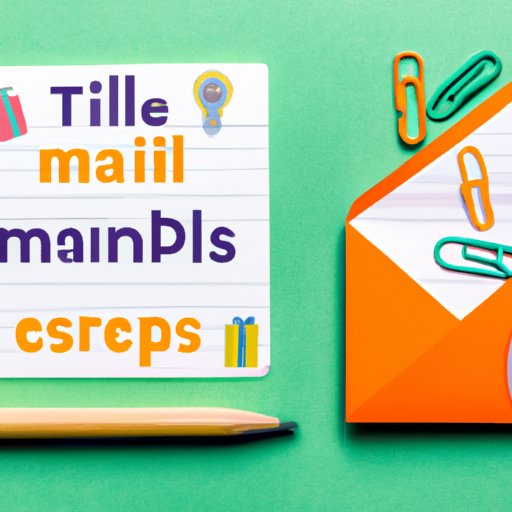
Introduction
When it comes to communication in the modern world, emails are one of the most commonly used tools. Whether it’s for work or personal communication, it’s important to write effective emails that convey the right message and tone. In this article, we’ll explore tips and tricks on how to write an effective email that gets your message across and builds relationships.
Start with an attention-grabbing subject line
The subject line is the first thing that catches someone’s attention in an email. It’s the opening pitch that entices the recipient to read further. A subject line should be short, specific, and attention-grabbing. Avoid generic subjects like “Hello” or “Update” and choose specific phrases that give the recipient a clear idea of the email’s content. A subject line that is too long may get truncated in a mobile device, so it’s important to keep it brief and impactful.
For example, instead of using “Project update,” try “Project status report: Q1 2021.” When sending an email to a client or someone you’ve never met, consider using their name in the subject line. “John, thank you for meeting us yesterday” is more likely to get opened than “Thank you for meeting us yesterday.”
Use a clear and concise opening sentence
The opening sentence of an email sets the tone for the entire communication. Avoid pleasantries like “I hope you’re doing well,” and go straight to the purpose of the email. Starting an email with “I’m writing to follow up on the project status” is more impactful than “I wanted to check in on our project progress.”
Keeping the opening sentence clear, concise, and specific sets up the tone for the rest of the email.
Keep paragraphs short and focused
Organizing the email in a logical and easy-to-read way is essential. Short paragraphs are more readable than long ones, and they help to keep the email focused. Use one paragraph for one idea or concept and move on to the next one. If you find yourself rambling in a paragraph, it’s time to start another one.
Avoid phrases like “In addition to that” or “Moreover,” as they make a paragraph longer and less effective. Use transition words and phrases to link paragraphs and maintain the flow of the email.
Be polite and professional
While emails can be less formal than other communication modes, it’s important to maintain a polite and professional tone. Using proper grammar, spelling, and punctuation is essential to avoid misunderstandings. Always use a salutation like “Dear” with the recipient’s name, or “Hi” if it’s an informal communication. Avoid using slang or abbreviations, as they can be interpreted differently by different people.
You can use phrases like “please” and “thank you” to show respect and appreciation. Close the email with appropriate greetings such as “Best regards” or “Sincerely” followed by your name and signature.
Use bullet points or numbered lists for clarity
Using bullet points or numbered lists is an effective way to communicate complex ideas and instructions. They make the email easier to read and understand. Use bullet points or numbered lists when providing action items, steps, or a series of information that is best presented chronologically or hierarchically.
When using bullet points, start each point with a verb or noun to make it clear to the reader. Use a consistent format for each bullet point, and avoid long sentences. When using numbered lists, number each item in chronological order and use the same grammatical structure for each point.
End with a clear call-to-action
The end of an email should prompt the reader to respond or take action. The call-to-action should be specific, clear, and easy to follow. Avoid being vague or assuming that the recipient knows what to do next. Provide specific information on what you want them to do and how they can do it.
For example, instead of ending an email with “Let me know if there’s anything else you need from me,” try, “Please send me the requested information by Wednesday at 5 pm so that we can complete the project on schedule.”
Proofread and edit before sending
Always take the time to proofread and edit an email before sending it. Check for grammatical and spelling errors, typos, and sentence structure. Make sure that the email is concise, coherent, and follows the desired tone and message. If possible, have someone else read the email before sending to catch any errors or unclear parts. Once you hit “send,” you can’t take the email back.
Conclusion
An effective email is one that conveys the intended message and tone, is easy to read, and prompts action or response from the recipient. To write an effective email, start with an attention-grabbing subject line, use a clear and concise opening sentence, keep paragraphs short and focused, be polite and professional, use bullet points or numbered lists for clarity, end with a clear call-to-action, and proofread and edit before sending. Practice these tips in your day-to-day communication and see how you can write more impactful emails that connect and build relationships.




